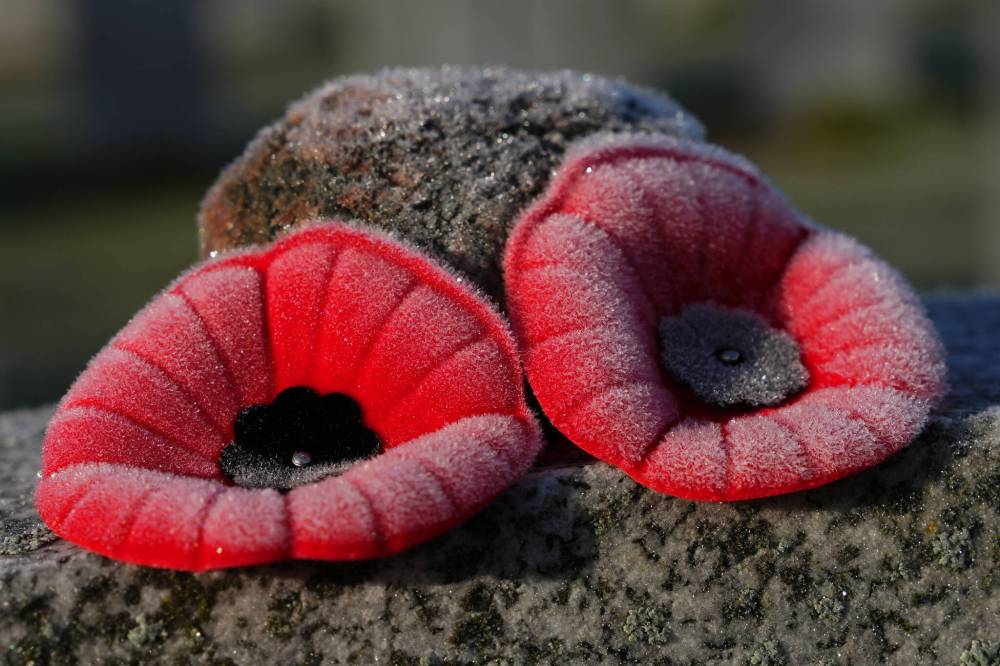Modern measures keep Remembrance Day relevant
Read this article for free:
or
Already have an account? Log in here »
To continue reading, please subscribe:
Monthly Digital Subscription
$0 for the first 4 weeks*
- Enjoy unlimited reading on winnipegfreepress.com
- Read the E-Edition, our digital replica newspaper
- Access News Break, our award-winning app
- Play interactive puzzles
*No charge for 4 weeks then price increases to the regular rate of $19.00 plus GST every four weeks. Offer available to new and qualified returning subscribers only. Cancel any time.
Monthly Digital Subscription
$4.75/week*
- Enjoy unlimited reading on winnipegfreepress.com
- Read the E-Edition, our digital replica newspaper
- Access News Break, our award-winning app
- Play interactive puzzles
*Billed as $19 plus GST every four weeks. Cancel any time.
To continue reading, please subscribe:
Add Free Press access to your Brandon Sun subscription for only an additional
$1 for the first 4 weeks*
*Your next subscription payment will increase by $1.00 and you will be charged $16.99 plus GST for four weeks. After four weeks, your payment will increase to $23.99 plus GST every four weeks.
Read unlimited articles for free today:
or
Already have an account? Log in here »
Hey there, time traveller!
This article was published 09/11/2022 (1124 days ago), so information in it may no longer be current.
During those first grey weeks of November, a splash of red brightens the lapels of coats — often also in varying shades of grey — across Canada. The crimson poppy, worn by so many as a symbol of bloodshed, of sacrifice, of remembrance; worn on the left side, above the heart, so we may never forget.
The annual poppy campaign, delivered by the Royal Canadian Legion, marked its 100th anniversary in 2021, making it almost as old as Remembrance Day itself. The tradition of wearing a poppy is inextricably linked with its source inspiration, the 1915 poem In Flanders Fields by Lt-Col. John McCrae — “In Flanders Fields, the poppies blow; between the crosses row on row” — and was first conceived by women: Madame Anna Guérin of France and Moina Michael of the United States.
These days, it’s a critical fundraiser: the Royal Canadian Legion’s poppy campaign raises $20 million for veteran support programs every year.
Mike Sudoma / Winnipeg Free Press Files The poppy is an enduring symbol of Remembrance Day.
But like any century-old institution, the poppy campaign has had to figure out how to evolve with the times — as with the recent introduction of tap-enabled poppy donation boxes, which makes it easier for those without cash to use their cards or smartphones to make a donation. Or this year’s Poppy Stories initiative, which will allow people to scan their lapel poppies with their smart phones to access information and anecdotes about Canadian vets.
Canadians can donate to the campaign online at mypoppy.ca, where they can also create a digital poppy that can be dedicated to a veteran and shared on social media.
The ubiquitous physical poppies, meanwhile, are becoming more environmentally friendly. The Royal Canadian Legion is in the process of phasing out its familiar plastic and felt poppies for biodegradable ones, which debuted this year. Recent years have also seen the proliferation of beaded poppies, to honour Indigenous veterans and soldiers who never came home.
These modernization efforts are admirable and, many would argue, necessary. It can be hard to engage Canadians, especially younger ones, on Remembrance Day. For many, Nov. 11 has simply become a day off, divorced from its intended commemorative meaning. Lowering the barriers to participation, whether by bolstering virtual offerings or creating more points of contact for donation, can be a useful strategy in getting more Canadians to embrace Remembrance Day. It’s a simple fact of human nature that people are more likely to do something if it’s convenient.
THE CANADIAN PRESS FILES The Royal Canadian Legion is in the process of phasing out its familiar plastic and felt poppies for biodegradable ones, which debuted this year.
There’s a risk, perhaps, in allowing these digital initiatives to reduce Remembrance Day to a “frictionless experience,” like that of mobile ordering a coffee or a ride. But sharing a digital poppy on social media is not functionally different than wearing a poppy on your lapel: both are a visual cue that you have donated to the poppy campaign and/or that you are observing Remembrance Day, however that looks to you.
While ceremonies play an important role in observation, Remembrance Day has always had an element of the personal: how people mark it (or don’t) and their reasons for marking it (or not) are theirs alone.
And still, for more than a century, the poppy has endured, by now outliving all who participated in the First World War. The poppy remains a symbol, regardless of the form it takes. What imbues it with meaning is the act of remembering.
Lest we forget.









